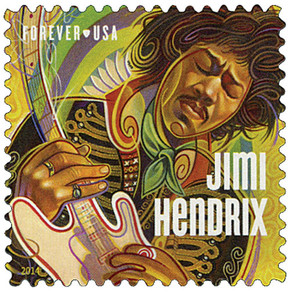
U.S. # 4786
2013 46¢ Lydia Mendoza
Music Icons Series
Crossing the Texas border, a four-year-old girl was doused with gasoline by immigration officials to kill lice. Putting poverty and humiliation behind, Lydia Mendoza (1916-2007) soon became the first icon of Mexican-American culture.
Like thousand... more
U.S. # 4786
2013 46¢ Lydia Mendoza
Music Icons Series
Crossing the Texas border, a four-year-old girl was doused with gasoline by immigration officials to kill lice. Putting poverty and humiliation behind, Lydia Mendoza (1916-2007) soon became the first icon of Mexican-American culture.
Like thousands of other immigrants fleeing the Mexican Revolution, the Mendoza’s made their home in the Texas borderlands and found work as migrant laborers. Lydia learned to play guitar from her parents and songs lyrics from collecting bubble gum wrappers, which had the words printed on them to promote music publishers.
The Mendoza women played music for money in plazas and cafes, a practice that was dominated by men. After the family hitchhiked to San Antonio, Lydia caught the attention of a local radio announcer. Live radio performances led to a recording contract in 1934. Lydia’s version of Mal Hombre, which she had learned from a gum wrapper, became an overnight success. Accompanied only by her 12-string guitar, Lydia’s clear, powerful song styling helped to make Tejano (Texas-Mexican) music popular.
Known as the “Lark of the Border” and the Queen of Tejano music, Mendoza became the first Texan to receive the prestigious National Heritage Fellowship lifetime achievement award.
Designed by Greg Breeding, the Mendoza stamp includes a 1950s photograph behind a design similar to the Texas flag. The stamp and full pane were designed to resemble a 45rpm record sleeve, with the pane picture part of a record peeking through the top.
Value: 46¢ 1-ounce first-class letter rate
Issued: May 15, 2013
First Day City: San Antonio, TX
Type of Stamp: Commemorative
Printed by: Avery Dennison
Method: Photogravure printing in sheets of 128 in 8 panes of 16
Perforation: Serpentine Die Cut 10 ¾
Self-Adhesive
Quantity Printed: 30,000,000 stamps
Lydia Mendoza has the distinction of being the first honoree in the U.S.P.S.’s Music Icons Series. Begun in 2013, it pays tribute to performers representing a variety of eras and genres. All the stamps and panes in the series are the same size, with the panes designed to look like record sleeves.















